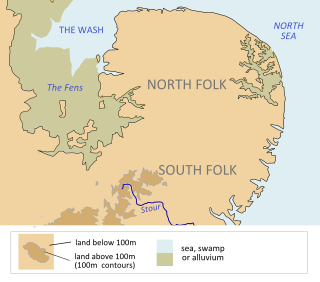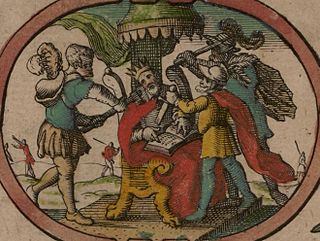
Rædwald, also written as Raedwald or Redwald, was a king of East Anglia, an Anglo-Saxon kingdom which included the present-day English counties of Norfolk and Suffolk. He was the son of Tytila of East Anglia and a member of the Wuffingas dynasty, who were the first kings of the East Angles. Details about Rædwald's reign are scarce, primarily because the Viking invasions of the 9th century destroyed the monasteries in East Anglia where many documents would have been kept. Rædwald reigned from about 599 until his death around 624, initially under the overlordship of Æthelberht of Kent. In 616, as a result of fighting the Battle of the River Idle and defeating Æthelfrith of Northumbria, he was able to install Edwin, who was acquiescent to his authority, as the new king of Northumbria. During the battle, both Æthelfrith and Rædwald's son, Rægenhere, were killed.
Æthelhere was King of East Anglia from 653 or 654 until his death. He was a member of the ruling Wuffingas dynasty and one of three sons of Eni to rule East Anglia as Christian kings. He was a nephew of Rædwald, who was the first of the Wuffingas of which more than a name is known.

Anna was king of East Anglia from the early 640s until his death. He was a member of the Wuffingas family, the ruling dynasty of the East Angles, and one of the three sons of Eni who ruled the kingdom of East Anglia, succeeding some time after Ecgric was killed in battle by Penda of Mercia. Anna was praised by Bede for his devotion to Christianity and was renowned for the saintliness of his family: his son Jurmin and all his daughters – Seaxburh, Æthelthryth, Æthelburh and possibly a fourth, Wihtburh – were canonised.
Ecgric was a king of East Anglia, the independent Anglo-Saxon kingdom that today includes the English counties of Norfolk and Suffolk. He was a member of the ruling Wuffingas dynasty, but his relationship with other known members of the dynasty is not known with any certainty. Anna of East Anglia may have been his brother, or his cousin. It has also been suggested that he was identical with Æthelric, who married the Northumbrian princess Hereswith and was the father of Ealdwulf of East Anglia. The primary source for the little that is known about Ecgric's life is Historia ecclesiastica gentis Anglorum, written by the English Benedictine monk Bede in around 731 AD.

The Wuffingas, Uffingas or Wiffings were the ruling dynasty of East Anglia, the long-lived Anglo-Saxon kingdom which today includes the English counties of Norfolk and Suffolk. The Wuffingas took their name from Wuffa, an early East Anglian king. Nothing is known of the members of the dynasty before Rædwald, who ruled from about 599 to c.624. The Viking invasions of the 9th century and Dissolution of the monasteries in the 16th century both led to the destruction of documents relating to the rule of the Wuffingas.

Ælfwald was an 8th-century king of East Anglia, an Anglo-Saxon kingdom that today includes the English counties of Norfolk and Suffolk. The last king of the Wuffingas dynasty, Ælfwald succeeded his father Ealdwulf, who had ruled for 49 years. Ælfwald himself ruled for 36 years. Their combined reigns, with barely any record of external military action or internal dynastic strife, represent a long period of peaceful stability for the East Angles. In Ælfwald's time, this was probably owing to a number of factors, including the settled nature of East Anglian ecclesiastical affairs and the prosperity brought through Rhineland commerce with the East Anglian port of Gipeswic. The coinage of Anglo-Saxon sceattas expanded in Ælfwald's time: evidence of East Anglian mints, markets, and industry are suggested where concentrations of such coins have been discovered.

Eadwald of East Anglia was an obscure king of the small Anglo-Saxon kingdom of East Anglia, from around 796 to 798 or later. He lived at a time when East Anglia was eclipsed by its more powerful neighbour, Mercia; after his deposition or death, Mercian control was restored under Coenwulf and the East Anglians lost their independence for a quarter of a century. Knowledge of Eadwald's short reign comes almost solely from the few surviving coins that were minted under his name. No details of his life, or rule as king, are known.
Ealdwulf was king of East Anglia from c. 664 to 713. He was the son of Hereswitha, a Northumbrian princess, and of Æthilric, whose brothers all ruled East Anglia during the 7th century. Ealdwulf recalled that when he was very young, he saw the Christian/pagan temple belonging to his ancestor Rædwald.

Felix of Burgundy, also known as Felix of Dunwich, was a saint and the first bishop of the kingdom of the East Angles. He is widely credited as the man who introduced Christianity to the kingdom. Almost all that is known about him comes from The Ecclesiastical History of the English People, completed by the English historian Bede in about 731, and the Anglo-Saxon Chronicle. Bede wrote that Felix freed "the whole of this kingdom from long-standing evil and unhappiness".
Sigeberht of East Anglia, was a saint and a king of East Anglia, the Anglo-Saxon kingdom which today includes the English counties of Norfolk and Suffolk. He was the first English king to receive a Christian baptism and education before his succession and the first to abdicate in order to enter the monastic life. The principal source for Sigeberht is Bede's Ecclesiastical History of the English People, which was completed in the 730s.

Eorpwald; also Erpenwald or Earpwald,, succeeded his father Rædwald as ruler of the independent Kingdom of the East Angles. Eorpwald was a member of the East Anglian dynasty known as the Wuffingas, named after the semi-historical king Wuffa.
Ricberht, may have briefly ruled East Anglia, a small independent Anglo-Saxon kingdom which today forms the English counties of Norfolk and Suffolk. Little is known of his life or his reign.

Eni or Ennius was a member of the Wuffing family, the ruling dynasty of the kingdom of East Anglia. He was the son of the semi-historical pagan king Tyttla and the brother of Rædwald, who both ruled East Anglia.
Æthelwold, also known as Æthelwald or Æþelwald, was a 7th-century king of East Anglia, the long-lived Anglo-Saxon kingdom which today includes the English counties of Norfolk and Suffolk. He was a member of the Wuffingas dynasty, which ruled East Anglia from their regio at Rendlesham. The two Anglo-Saxon cemeteries at Sutton Hoo, the monastery at Iken, the East Anglian see at Dommoc and the emerging port of Ipswich were all in the vicinity of Rendlesham.

Wuffa is recorded in the Anglo-Saxon genealogies as an early king of East Anglia. If historical, he would have flourished in the 6th century.
Wehha of East Anglia is listed by Anglo-Saxon records as a king of the East Angles. If he existed, Wehha ruled the East Angles as a pagan king during the 6th century, at the time the region was being established as a kingdom by migrants arriving from what is now Frisia and the southern Jutland peninsula. Early sources identify him as a member of the Wuffingas dynasty, which was established around the east coast of Suffolk. Nothing of his reign is known.
Alberht was an eighth-century ruler of the kingdom of East Anglia. He shared the kingdom with Beonna and possibly Hun, who may not have existed. He may still have been king in around 760. He is recorded by the Fitzwilliam Museum and the historian Simon Keynes as Æthelberht I.
Hereswith or Hereswitha, also spelt Hereswithe, Hereswyde or Haeresvid, was a 7th-century Northumbrian saint. She married into the East Anglian royal dynasty and afterwards retired to Gaul to lead a religious life. Hereswith's sister was Saint Hilda, founder of the monastery at Whitby. Details of her life and identity come from Bede's Historia Ecclesiastica, the Anglian collection and the Lives of Edwin of Northumbria and Hilda of Whitby.

The Kingdom of the East Angles, today known as the Kingdom of East Anglia, was a small independent kingdom of the Angles comprising what are now the English counties of Norfolk and Suffolk and perhaps the eastern part of the Fens. The kingdom formed in the 6th century in the wake of the Anglo-Saxon settlement of Britain. It was ruled by the Wuffingas dynasty in the 7th and 8th centuries, but fell to Mercia in 794, and was conquered by the Danes in 869, to form part of the Danelaw. It was conquered by Edward the Elder and incorporated into the Kingdom of England in 918.









